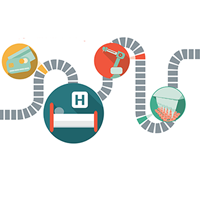Visualizing the cell and gene therapy supply chain of the future
Cell Gene Therapy Insights 2016; 2(2), 237-242.
10.18609/cgti.2016.030
Interview Dr Phil Vanek INTEGRATION OF MANUFACTURING & DELIVERY INTO HEALTHCARE Dr Phil Vanek is General Manager of GE Healthcare’s Cell Therapy Technologies business, a business initiative funded in part by GE Healthymagination, a $6 billion strategy to revolutionize the world’s health by improving the quality, access and affordability of care. Prior to joining GE, […]

Interview
Dr Phil Vanek

INTEGRATION OF MANUFACTURING & DELIVERY INTO HEALTHCARE
Dr Phil Vanek is General Manager of GE Healthcare’s Cell Therapy Technologies business, a business initiative funded in part by GE Healthymagination, a $6 billion strategy to revolutionize the world’s health by improving the quality, access and affordability of care. Prior to joining GE, Phil was Head of Innovation for Lonza’s Pharmaceutical division, leading a group of research scientists, process development engineers, and commercial strategists to drive new technology initiatives focused on cell, protein, and viral therapeutic manufacturing. Phil’s career has included a number of senior innovation, business and market development roles at Becton Dickinson, Invitrogen, and Life Technologies, as well as two start-up biotechnology companies in the Washington, DC area. Phil received his Ph.D. in Biochemistry and Molecular Biology from Georgetown University Medical Center and subsequently held an IRTA fellowship at the National Cancer Institute in the Laboratory of Molecular Oncology. Phil is an active member of the Alliance for Regenerative Medicine, where he currently serves as an Officer of the Executive Committee. Phil has also been recently elected to the Centre of Commercialization of Regenerative Medicine (CCRM) Board of Directors in Toronto, Canada, and serves on the Editorial Board of Cell and Gene Therapy Insights
DOI:10.18609/cgti.2016.030
Citation: Cell Gene Therapy Insights 2016; 2(2), 237-242.![]()
![]()
GE Healthcare works with leading groups within academia and industry – from these interactions, do you get a sense of any major differences in what they perceive as the key translational challenges for cell and gene therapies?
The two main translational challenges in cell and gene therapy are similar to any other human therapy: showing safety and efficacy in patients, and creating a viable supply chain for commercialization. What we are typically hearing from the business leaders we work with is that there are not a lot of people who have the skills and experience to translate laboratory research into commercially manufacturable products. In the translational space, science is moving ahead very well and the clinical data is showing significant promise; but the worry is, where do we find the resources, the talent and the know-how to convert these from lab-scale processes into industrial-scale commercialized medicines?
As we start to see a proliferation in the number of cell and gene therapies moving towards the clinic, what do you see as the key requirements that are critical to their integration into routine clinical use?
Interestingly, a lot of these things are working their way through the clinical centers. As much as we hear about the leading pharmaceutical companies diving into the immuno-oncology space, there is also significant progress taking place in some of these larger clinical centers. In fact, clinical centers are the source of many of the technologies which are driving pharmaceutical company interest. There is a sense that there is a convergence of production pathways between pharmaceutical and technology developers and the clinical practice. The production and the care pathways will undoubtedly need to merge in the future and that’s something we’re not really paying sufficient attention to – adoption by physicians. How do we encourage, train and drive adoption of these therapies by physicians as it is an unfamiliar field for many of them?
An exciting collaboration between CCRM and GE was announced earlier this year. What are the strategic goals of this initiative and how will this support the commercialization of cell and gene therapies?
At the time when we were a member of the CCRM (Centre for Commercialization of Regenerative Medicine) consortia, we had a number of discussions with Michael May (CEO of CCRM), as well as a few other constituencies and stakeholders in that organization and there was a recognized need for quality process development in the industry. Where do we get technologies today? We typically borrow from the blood processing industry; we borrow from the bioprocessing manufacturing industry. There was a sense that we had to develop better technologies and where better to do that than in a center where you’re working on real world problems. A key part of this collaboration will be the development of a center for advanced therapeutic cell technologies in Toronto, Canada. As a tool provider, GE don’t always have access to that and we work one to one with specific key opinion leaders. But this collaboration presented an opportunity to build a center focussed specifically on addressing some of the key manufacturing challenges, and identifying and developing new pieces of equipment that would more accurately fit the purpose.
What do you hope to learn from working with the CCRM, which is a very translationally focused entity?
CCRM is an organization tailored to commercializing regenerative therapies and we share a common vision of industrializing the technology. It is not just about advancing science for the sake of science, there has to be a commercial outcome, and we felt that was a good strategic fit between the two organizations. More importantly, CCRM sits in the heart of Toronto, Canada, it is in the middle of several world class clinical centers which all have their own cell therapy trials and work taking place. This creates a sense of feeling that we’re in the heart of a clinical environment that’s well respected. Secondly, is our association with the University of Toronto where we work closely with the well-regarded biotechnology/bioengineering expert Prof. Peter Zandstra. Through this collaboration we have access tap into not only that knowledge resource, but also the graduate students, faculty and clinical settings of the University.
Underlying all of that is the notion that there should be financial capability or awareness minimally that would then drive these towards a commercial outcome and those were the ingredients that coalesced into this opportunity. In addition, the Canadian government’s commitment to add funding of their own and in partnership with a company like GE, makes it unique. We’re still figuring out things, but we see it as an interesting opportunity to try things on and see what works.
Undoubtedly there’s a real sense of optimism and momentum building in the sector, catalyzed by the recent immuno-oncology data. Do you feel this progress is being mirrored by the advances in manufacturing?
People are starting to recognize that these are living drugs and therefore the biology is becoming better understood. The key uncertainty that remains is the fact that we start to manufacture these therapies based on treating 150 to 500 patients, and then we need to make that jump into the commercial setting where we are potentially treating 500,000, a million, 5 million patients. This presents a big concern for the field but as we start to manufacture at that scale, we are in effect starting to build the factory of the future.
We are still grappling with some key questions about the manufacturing process: Are we substantially changing the cell itself during the process for example? We don’t have sufficient tools to measure the effectiveness of these cells or their potency; we lack good comparability tests at this point in time and are unaware of the implication to the end therapeutic product if the process is changed. All of these issues have not been fully addressed yet.
You mention the factory of the future – what is your vision for how this will look?
Reducing cost of goods is going to be a barrier for cell and gene therapies to be routinely adopted into the healthcare system. The manufacturing challenges are what drives costs into production and therefore what will need to evolve in order to reduce this barrier to commercialization. The factory of the future must to look at the expensive facilities that are used today such as clean rooms, heavy labor involvement, logistical challenges of moving materials in and out and sourcing the supply chain. There are all these factors that connect to make things work and in some therapies we will be achieve some some economy of scale as we start to treat more patients, but those incremental improvements and cost savings are not going to be enough. So we need to find new ways of doing things rather than just trying to work with existing systems and technologies. First and foremost, we need to move out of the clean rooms – they impose a big restriction on our ability to produce these products. To achieve that transition, the technology that we use today has to change. It has to be connected and fully closed systems. It has to remove the risks in processing so that there’s an opportunity to work in environments much more closely related to a hospital clinic; remove the blood or bone marrow or cord blood or whatever the starting material is, process it, expand it, develop it and then return it to the patient in a safe and simpler way.
At what stage do you typically see cell and gene therapy companies starting to think about these issues around manufacturing. Is it early enough or is it still a bit downstream?
There’s been a big push for clinical effectiveness and we all know that data talks. What’s great is that the data is starting to demonstrate some very promising efficacy in certain diseases, which is great because that essentials fuels the funding and excitement in the field. But in terms of when companies are starting to think about the practicalities of commercializing their therapy, you could argue that it’s never soon enough. You need to be thinking about the comparability when you introduce new technologies into the manufacturing process, are you materially changing the cell, the therapy, the potency. There’s currently no way to know that before they start these experiments.
There’s this notion that we’re going to focus on getting these products from bench to bedside, but there’s definitely not enough thought going into what does that look like when we are producing at scale and this conversation has to continue to evolve. We are driving it, as are many of our peer companies are as well, but it’s not solely about adapting our platforms, it’s about finding ways of doing things smarter.
There are also a number of challenges in terms of delivering these therapies to patients; how do you think this is going to evolve over the next 5–10 years?
The fact that we are making a very complex therapy, which is also a drug, has a lot of implications in terms of the regulatory paths they follow, delivery into healthcare settings, scheduling and the management of raw materials through to the production process. Mostly we’ve been talking about autologous therapies which have that additional chain of custody and patient tracking requirements. But a lot of these issues will also apply to allogeneic therapies.
The world’s changing, the physician used to have a list of off-the-shelf treatments they could prescribe and they would be readily available at the clinical centers where he/she could come in and say this patient requires A, B and C. With cell and gene therapies, a lot of them are built for purpose. They are patient-specific precision medicines with a great deal of complexity in terms of scheduling treatment of the patient, and management and follow up of the patient. We talk a lot in the sector about durability; how do we know how durable these products really are? To help inform the field, we need to be capturing and sharing the data from the clinical centers treating patients with cell and gene therapies. A lot of information flows into the clinical center’s systems and there is a real need to manage this digital information to learn and innovate. And finally I think it’s inevitable that traditional clinical care and manufacturing pathways will converge in order to successfully see these therapies in routine clinical care.
You mention the importance of data management as part of the biologistics pathway. GE have recently set up an initiative called the Vitruvian networks. Could you tell us more about that?
I have been in conversation with a number of the key opinion leaders and asked them if they could walk us through the steps from the moment a patient is diagnosed through to the point where the patient is treated and the follow up care provided. Throughout the process there are a lot of moving parts and many of those moving parts are disconnected which means multiple data entries, opportunities for errors to be introduced into the process, high manual labor which often leads to human error. Through Vitruvian networks, GE’s digital platform, we will be able to use some of the tools that GE has available through our software, to solve some of those problems. So it’s not necessarily re-inventing what already exists. There are a lot of scheduling systems and quality management systems out there. But it’s finding ways to make that data flow and connect, in order for us to start to addresses the specific needs and requirements of these therapies. Those are not met well today and through the Vitruvian networks and GE healthcare business, there is an opportunity to leverage our capabilities and competence to bring something new to the market that will be of added value.
Where do you feel that the real opportunities lie for innovation to catalyze the successful commercialization of cell and gene therapies in the near future?
On the therapeutic side, CAR-T therapies have been showing astounding results witih some of the clinical data showing 93% full durable recovery in chronically ill patients which is incredibly promising. We’re talking for the first time about medicines that will ‘cure’ and this means that there will be a great deal of changes in the reimbursement system in future. There’s also a notion to change the way we think about healthcare and health economics – how we make these new therapies, who and where are the manufacturing is being performed. Hospitals are starting to perform like pharmaceutical companies and pharmaceutical companies are on the verge of opening clinics. The world is going to be quite different in the next 15 years. Although exciting, there is significant progress that has to be made and with that, a number of challenges that have to be overcome along that path. But over the coming years I think we will see some very creative solutions being developed that will help get us closer to delivering on the promise of cell and gene therapies.
You can watch our exclusive interview with Phil here
Affiliation
Dr Phil Vanek
General Manager Cell Therapy Technologies, GE Healthcare
